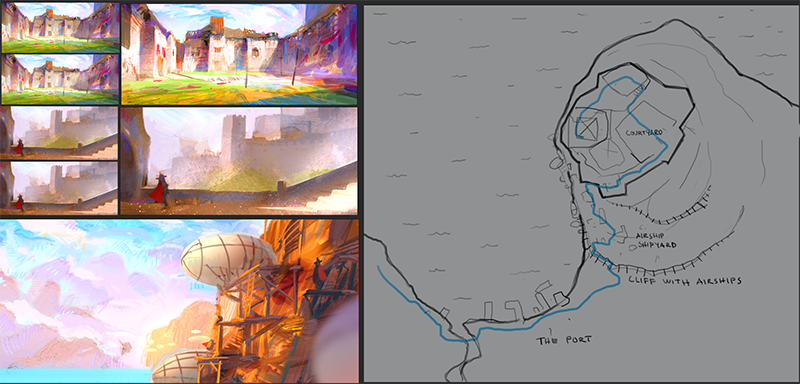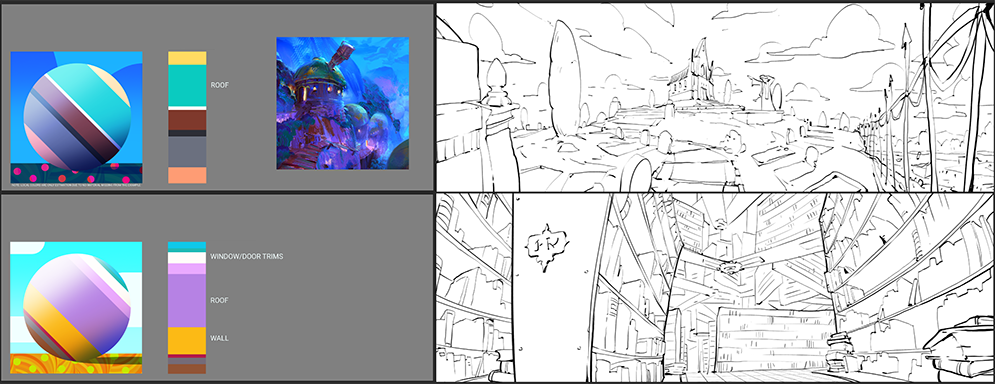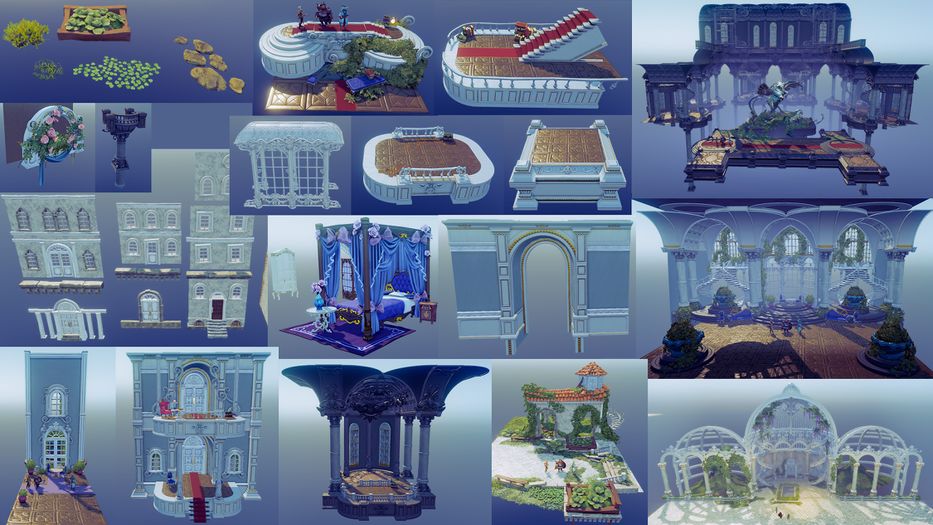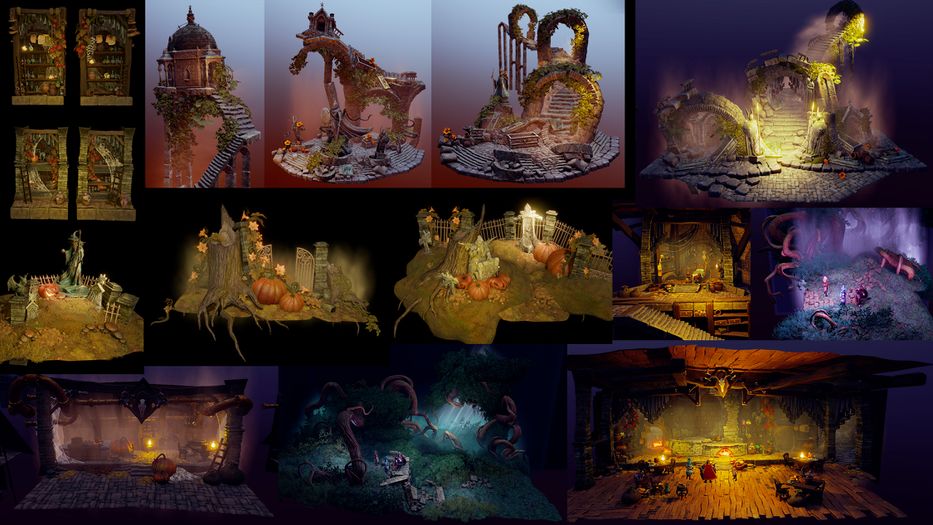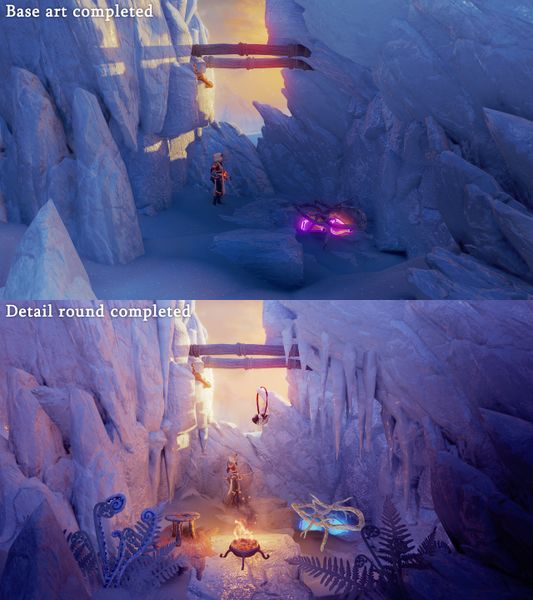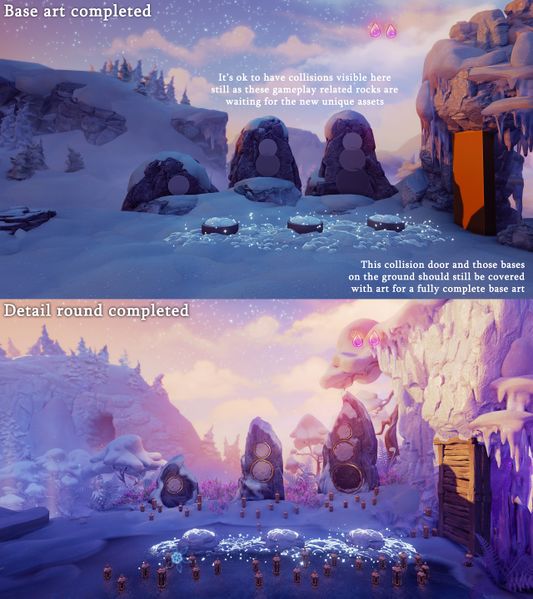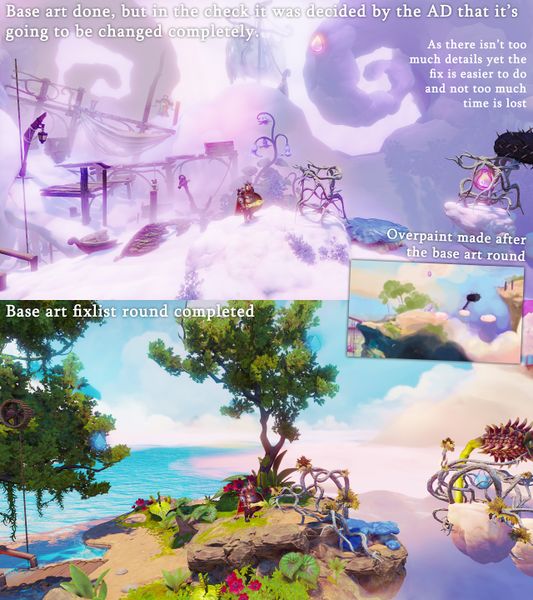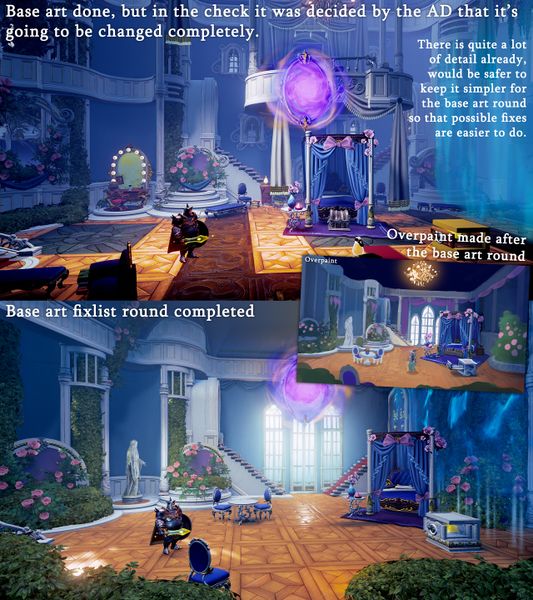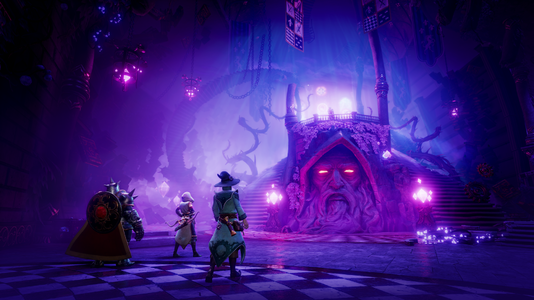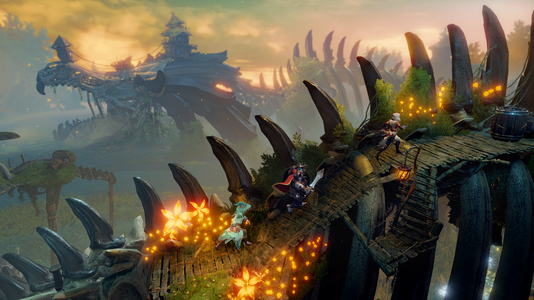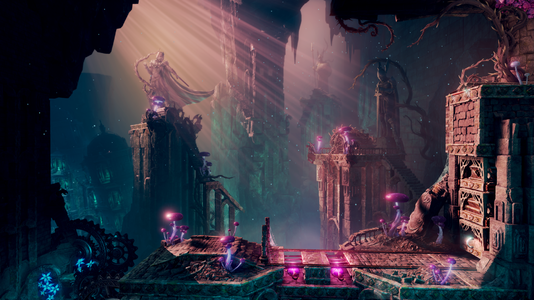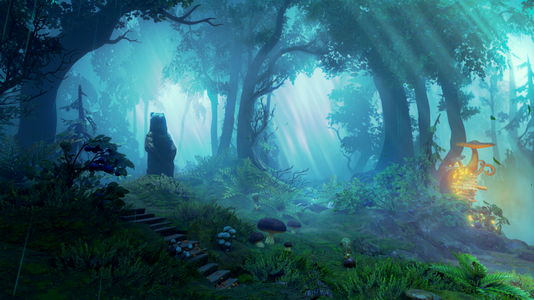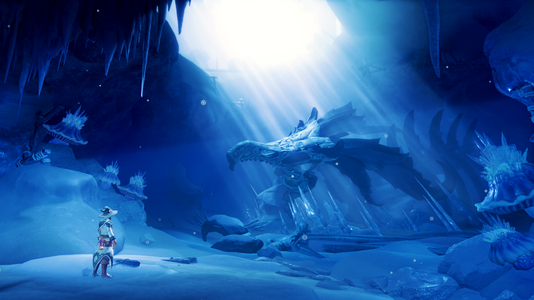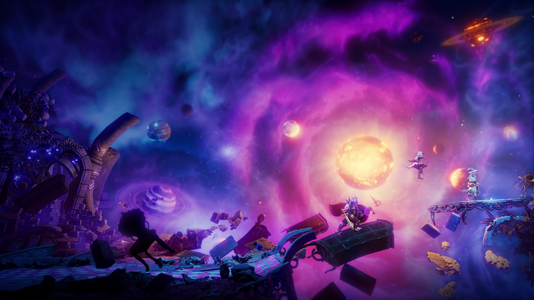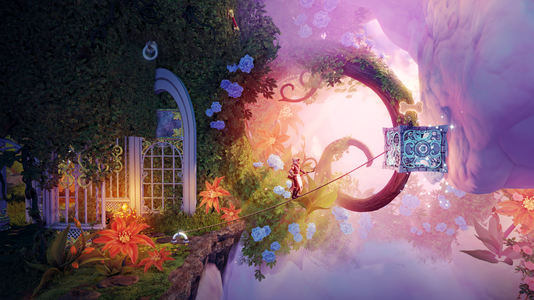Difference between revisions of "Level Art: The Level Art Phases"
(→Requesting New Pieces to 3D Asset Sets) |
(→Detailing) |
||
| Line 221: | Line 221: | ||
* Pay attention to the consistency of your art in a single level and of the whole game: there shouldn't be some areas filled with details while some are completely empty. | * Pay attention to the consistency of your art in a single level and of the whole game: there shouldn't be some areas filled with details while some are completely empty. | ||
* Always iterate gradually. It's tempting to fill one area from top to the bottom with detailed and finished art - and then move on to the next one, but you might end up running out of time and ruining the coherent feel of the level. | * Always iterate gradually. It's tempting to fill one area from top to the bottom with detailed and finished art - and then move on to the next one, but you might end up running out of time and ruining the coherent feel of the level. | ||
| − | * [[ | + | * [[Level Art: Environmental Storytelling|Environmental storytelling]] should guide your work while detailing. |
* The level design might change during the detailing phase, forcing you to consider and adjust your level art accordingly. | * The level design might change during the detailing phase, forcing you to consider and adjust your level art accordingly. | ||
* When the detailing phase is over, each level of the game should be "good enough". The sooner the levels reach that state, the better. | * When the detailing phase is over, each level of the game should be "good enough". The sooner the levels reach that state, the better. | ||
Latest revision as of 16:49, 23 November 2021
Related sites
Contents
The Level Art Phases
It's crucial to play the game as often as possible and during the whole level art process. Only by playing you can confirm that everything works as intended and see how the art looks in the game! It's your responsibility to ensure that the level art supports the gameplay in each part of the level. The player can only see what the in-game cameras are showing, making playtesting the level even more important.
- The level art process in a nutshell:
- 1) Reference and Research
- 2) Preassembly
- 3) Base Art Blocking
- 4) Detailing
- 5) Polishing & Optimizing
- + Feedback. The level artist receives feedback during the whole level art process.
- Communication is important. Talk with AD, asset artists, other level artists and designers. These conversations should happen often; constant communication is needed throughout the whole level art process.
- Base art is the most important part of the level art process. If the base art is lacking, nothing works - no matter how many pretty details you stamp over it.
- The level art work is done iteratively, keeping the state of the art coherent throughout the whole level constantly. In other words, unfinished areas with bare collisions and areas with finished, detailed level art shouldn't co-exist within the same level.
- The whole level should stay as playable as possible at all times. If your art assets (even the temporary ones) result in hindering or preventing the level from being played, you shouldn't use them.
Level Art Scheduling
- The time needed for the level art process is usually allocated as follows: The Base art takes 60%-70%, detailing 20%-30% and polishing 10%-20% of the time.
- Ideally, the time required to build a level from scratch to finish is roughly 3 months (about 60 workdays). It leaves enough time to commit the base art and polishes properly and tackle any surprise work that may emerge.
- If in a hurry, a level can be built as quickly as in 2 months (about 40 workdays). There's enough time to commit the base art and polishes adequately, but there's no room for errors or any surprises.
- There are multiple factors that can affect the level building duration, for example:
- The quality of the base art work (or any other art phase work, of course, but since the base art is the most important, fixing and fine-tuning it will take the longest)
- Changes in the level design schedules
- Sudden problems unrelated to the level artist/art team
- 3D assets missing/pending
- Changes in the gameplay design, requiring level art modifications
- Co-workers (designers, for example) needing to work on a level at a crucial time
- Sick leaves and personnel changes
- Unexpected and surprising issues
Level Art Process Steps
- Before level art process starts: Familiarizing yourself with the references available and researching the topic
- Before level art process starts: level meetings with AD, 3D art lead and the level artists and designers that are/will be working on the level
- Preassembly: No access to the actual map file yet, building the level art arrangements and asking for feedback from the AD
- Base art: Preliminary lighting setup
- Base art: Blocking the level art, building a strong and working base that supports the gameplay, covering all the collisions - keeping it simple!
- Base art: Camera fix list: adjusting the cameras to function as good as possible (considering both the gameplay and art), consulting designers
- Base art: AD's check and writing a fix list
- Base art: Fix list round where the base art is improved according to AD's feedback
- Base art: Lighting adjusting
- Detailing: Adding details on the base art
- Detailing: AD's check and writing a fix list
- Detailing: Fix list round where the level art is improved according to AD's feedback
- Polish and optimizing: Optimizing, adjusting lighting and fine-tuning level art until the time runs out. Multiple people can add more fix requests to the fix list when the content lock is approaching.
Example Art Schedule for One Level
- The timeframe for building levels is 65 workdays per level
- Some tasks can be done simultaneously, including base art checks, camera fixes and lighting polishes. An example: Camera set-up can be pre-built for a different scene and then copied to the final level after the lighting polishes have been finished.
- You can keep editing the level during any AD's check since AD won't be saving anything.
- There are times when you can't access the level due to a co-worker editing it, but you can create a duplicate of the level and continue your work there. When the level file is available again, just copy and paste your work from the duplicate to the original level.
- When unable to access a certain level, you can also start working on another level.
- Colors explained:
- Level artist (Responsible of this level)
- Camera artist
- Lighting artist (Optional, there could be none or several level artists responsible of the lighting as a whole)
- Art Director
| 20 days | 2 days | 4 days | 20 days | 3 days | 10 days | ?? days | 5 days | 1 day | ?? days |
|---|---|---|---|---|---|---|---|---|---|
| Base art | Lighting polishing | Base art fix and detailing | Lighting polishing | Details fix | Wait for puzzle versions, work on another level |
Puzzle versions art | Coop playtrough with level artists | Final polish | |
| Camera fix | |||||||||
| Camera check | Base art check | Details check | Random checks |
Research and Reference
- All the developers need to work towards a common goal, and it's everyone's responsibility to keep that goal in mind.
- To help everyone to share the same vision and understand the project as a whole, there are tools available:
- When hopping aboard a new project, go through the reference materials to familiarize yourself with the overall vision, goals and tone of the project. Refer to these materials regularly during the project.
- If you're a level artist, study the basics of Environmental Storytelling.
Script
- Read the whole script at the beginning of the project.
- When beginning the level art process for a new level, go back to the script and read again the section describing that level.
- You should re-read (parts of) the script every now and then to make sure all the details and ideas are reflected in your level art.
Wiki and Concept Art
- When assigned to a new level, go through the wiki page for that level - and keep editing and reading the page during the level art work.
Preassembly
- Preassembly isn't usually scheduled, allowing the level artist to do it whenever there's time.
- Preassembly means working on the level art before you can access the actual collision-blocked map file with all the puzzles and design. The goal is to eliminate any idle waiting time.
- During the preassembly face, you should familiarize yourself with the level theme and assets without distractions.
- The most important preassembly work is creating a solid library of level art arrangements. Take your time and choose the arrangements that best suit the level: some assets in the library might be scrapped but most of them should end up in the final product.
- Use the preassembly time to try out your ideas. It's a perfect time to play around and experiment without paying any attention to the level geometry restrictions of the real level.
- You can quickly build rooms, backgrounds, focal point arrangements, gameplay platforms etc. without worrying where to place them exactly.
- Since preassembly creations are not integrated with the actual game collisions, it's much easier to edit them if something doesn't feel right.
How to Preassemble
- Gather a bunch of ideas by reading the script, familiarizing yourself with the level wiki site, browsing through the new level assets and possibly searching online reference images.
- With a head full of ideas, start building level art arrangements for the level. Begin with the necessary must-have objects needed in the level and create more as you go.
- While creating the preassembled arrangements, you'll probably start developing some kind of an idea concerning the structure of the level.
- Every level should have a focal point area in the beginning and in the end. Figuring out how those areas are executed is a great place to start.
- It's easiest to start with story areas described in the script, areas with existing concepts and/or areas you have a strong vision in mind for already.
- Be careful not to add too many details, as the detailing phase happens only after the preassembled arrangements are placed in the actual level map and the base art is satisfactory.
- Once you're happy with an arrangement, you can store it under the null (the null object in Editor) for easier handling.
Possible Pitfalls
- While it allows you to experiment freely with the level, there are some issues you may encounter during the preassembly phase:
- Incoherent and disjointed level flow: The flow of the level needs to be coherent from the start to finish. Be careful when arranging separate pre-made blocks of art together and pay special attention to "in-between" transition areas. Keep the big picture in mind.
- Detached feel: Copying the preassembled arrangements to an actual level may result in a feeling of not belonging. The pieces might look and feel like a separate backdrop floating behind the 2D game area (that's actually what they are, in fact, but they shouldn't feel like that). When adding your arrangements, integrate them seamlessly into the gameplay area.
- Under-optimization: A seemingly small piece of extra geometry is multiplied rapidly when the arrangements are duplicated. To avoid repetition and clumsiness, optimize the use of your preassembled arrangements.
- Too many details: The preassembly phase is followed by a base art phase. If the preassembled content is detailed and complex, it'll make the base art phase overly complicated and will slow the progress down.
Base art
The first on the foremost purpose of level art is to support the gameplay and bring out the important game objects as well as possible. A visually pleasing game is an important goal on its own, but the level art must always submit to the gameplay. When the base art phase is over, there should be a fully playable level with both art and the gameplay functioning and complimenting each other.
It's crucial to play the game as often as possible and during the whole level art process. Only by playing you can confirm that everything works as intended and see how the art looks in the game! It's your responsibility to ensure that the level art supports the gameplay in each part of the level. The player can only see what the in-game cameras are showing, making playtesting the level even more important.
Cover and Match All the Collisions
- Once a designer is finished with a level, it's handed to a level artist. It's time for the base art phase.
- Base art phase is scheduled - it's important to fill the level with art as soon as possible.
- During the base art round, art elements are added to a level for the first time. Everything is built on top of the base art, so it's very important to get it right.
- Base art phase includes covering all the visible collisions.
- Note: If you match the collision areas and art carefully during the base at phase, it'll save a lot of time and the need to fix them later.
- Go through all the areas the player can interact with and check the collisions - remember not to consider only the characters but also the wizard's levitating objects.
- Pay attention to smaller things as well, like floating rope targets. The aim is to cover and support all gameplay elements with art so that the game can be played and enjoyed after the base art phase.
- Go through the level from start to finish. Play the level yourself with a character and make sure the collisions work as intended (AKA characters aren't floating or walking inside assets and characters or levitation objects won't get stuck on invisible collisions).
Focus on the Big Picture
- During the phase art base, do not add small details. If the base geometry goes through changes and level art needs to be altered, additional art details slow down the process a lot: checking the level, doing paint-overs and fixing the base level art is really difficult if there are a lot of details.
- After the art blocking phase the level should look and feel "complete", serving as a solid base to add things later on.
- Even if you must work with placeholder 3D assets, try to match the proportions from the start.
- Don't spend too much time creating intricate, highly detailed placeholder areas. Rather use temporary structures, instead, or, if you must, leave the area empty while waiting for assets.
- Divide your work into steps, to avoid spending all your time on a single finalized scene and neglecting other areas. Focus on a single run throughout the whole level.
- A safe place to start are the walls, ground, floor and other environmental elements making up the big objects.
- The backgrounds are an important part of the base art. They play a huge role in creating the big shapes and the visual flow.
- When working with outside locations, don't forget the sky - or you're missing out on a big part of the screen. Remember to add the clouds and weather elements etc. They are a very important part of the level's general flow.
Basic art principles are present from the start
- Level Art: Composition The composition and flow guide the player through the level. Tip: Select the right materials for the shapes, and never use assets scaled too large, unless you can hide them well.
- Level Art: Color and Lighting Color and lighting can be used to guide the player as well. Tip: Use the values and contrasts so that the important things pop out and unimportant things blend in. Invite the player towards their intended path with lights and use darker tones for those parts of the screen the player is not supposed to stumble into.
Don't Let the Collisions Restrict You When it's Not Necessary
- The collisions are implemented by level designers - while they pay attention to art details as well, their job is designing the game, not making art.
- Never edit the collisions or gameplay objects without consulting the designers first - but don't be afraid to ask about the matter. Have a conversation with the designer about the changes you wish to make, and if they agree, proceed.
- The gameplay area is a narrow 2D plane, the width of it being only about 2 metres. The collision rules, for example, are applied only inside those two-meter borders. Your job is to blend the gameplay area into the surrounding 3D scene and to make it a believable part of the world (as opposed to an artificial, detached lane).
- As long as your foreground or background items don't distract the player from the important gameplay things, feel free to experiment and go wild.
- It's not necessary for the background and foreground areas surrounding the gameplay area to follow the general shape of it. On the contrary, they should be used to create depth and hide the fact that the actual game happens in a narrow, straight line.
Requesting New Pieces to 3D Asset Sets
- Level artist uses the 3D asset sets created by 3D artists to build levels - and figure out simultaneously how the various asset pieces work.
- Don't hesitate to give feedback to 3D artists and/or request art from them. Both you and the 3D artist benefit when useful and visually satisfying asset sets are created.
- The 3D artists create the assets and don't really build levels with them. To make full use of all assets and connect them together, it's likely you'll need to ask for more parts.
- If you need more asset pieces created, compile a list of your needs during the base art base and deliver it to the 3D art lead.
- For example, you might ask for more differently sized pieces to a wall set, if scaling the size of the old ones up or non-uniformly will result in the visual quality suffering.
- Note: It's fine to use the too-much-up-scaled or non-uniformly-scaled versions of the pieces for the first version of your base art. Request the new 3D pieces by the end of the base art phase and replace the old assets with new ones later.
- Tip: If possible, it's better to gather a list detailing all your needs than to ask for a new 3D set piece every day.
- Tip: When building temporary structures from currently available assets, write down their measurements and describe the shape that you want the new assets to be. Pass your notes along with your asset order list to the 3D artist who can use them as a reference.
Prioritize the focal point areas
- Start with the focal point areas (beginning, ending, story areas, special art areas etc.) and plan the rest of the base art around those scenes.
- The level start and end areas are usually focal point areas, as we want the first and last thing the players see to look extra nice.
- Not every single frame can be a focal point one, but there should be more general areas between instead. By alternating the various scene types it's easier to avoid player exhaustion, create rhythm and emphasize the special areas.
- Since the game project is on the clock, it's best to schedule and plan carefully before the actual work.
- 2D angled games (like Trine) face issues with matching the organic art to the straight collisions. To avoid that, you might feel tempted to create natural rock formations with perfectly straight 90-degree angles. Try keeping the rock formation as natural as possible, instead, while strictly following the gameplay collision areas and rules (the foreground and background area are not tied by the gameplay area rules). If a straight/90-degree surface must be included, you can use man-made constructions (brick, wood) rather than pursuing the "natural" rock look.
Focal points
- Focal points are very delicately planned and beautifully built areas inside the level.
- They can be impressive and unique hero assets or just small asset arrangements built out of ordinary assets (nicely composed and made look perfect for the specific camera angle).
- Most of the level should consist of the "basic environment"; focal points are located here and there to spike interest.
- You can also use carefully crafted small lighting scenarios as points of interest, like a warm ray of light emerging from a hole in the cave wall, illuminating some mushrooms/rocks/etc.
- In Trine games you should place the focal points between the puzzle areas. Scenes containing puzzles should be clear of any distractions, allowing the players to fully focus on solving the puzzle.
- The puzzle areas shouldn't look boring, either, but it's a good practice to build the various areas of the level to highlight their function.
- If there's not enough space for an important focal point area in the game, talk to the designer. Usually, they are willing to add the needed space to the level.
- Reference images are especially important when building focal point areas, so study and search for new images!
- Even if two levels share a theme, each level should have a unique feeling of its own.
- There should be something special and visually memorable in each level: A point that evokes feelings and makes the level remarkable. For example, a shark swimming by, a unique geological formation or the oldest classic - a breathtaking scenery point.
Detailing
- When the detailing phase is reached, it's a race against the clock to get all the levels finished on time, thus making the detailing phase a tightly scheduled one.
- The level is already filled with functioning and pleasing visuals. Details are added for plausibility reasons, and to pique visual curiosity, to create depth and to add to the level's visual charm.
- The level base is optimized during the detailing phase to make sure there isn't any excess geometry left.
- Pay attention to the consistency of your art in a single level and of the whole game: there shouldn't be some areas filled with details while some are completely empty.
- Always iterate gradually. It's tempting to fill one area from top to the bottom with detailed and finished art - and then move on to the next one, but you might end up running out of time and ruining the coherent feel of the level.
- Environmental storytelling should guide your work while detailing.
- The level design might change during the detailing phase, forcing you to consider and adjust your level art accordingly.
- When the detailing phase is over, each level of the game should be "good enough". The sooner the levels reach that state, the better.
- In theory, once the detailing phase ends, each level should be ready to ship (if, for some imaginary reason, there were no time or resources for any polishing). That means art is coherent and of good quality, supporting the gameplay. There shouldn't be any major visual issues. In reality, the Trine levels are always polished and fine-tuned.
Polishing
- Usually not a scheduled phase, as the levels entering this stage have reached the "good enough" standard mentioned earlier.
- The remaining time (until the content lock day) is spent fine-tuning everything as much as possible.
- Polishing is done last to ensure the overall quality of all levels. Each level should reach the "good enough" state before any polishing on any level happens.
- Note: If you have gaps in your schedule during the earlier level art phases (while waiting for access to a certain level, for example) it's ok to do some polishing work as well.
- The Trine game levels are polished until the last possible moment, and none of the levels is considered "final" until the game launch day.
- Even when polishing you need to consider the general art quality and aim for coherence throughout the game: some levels can't look more polished than the others.
- New 3D assets might appear during the later stages of the project, and they are distributed evenly among the levels.
- Polishing phase entails minor detail fixes and also bigger base art level fixes. The development is a constant flux: some brilliant ideas come up late and some previously functioning concepts are abandoned during the later phases.
- While it's not recommended to implement any radical changes during the polishing phase, don't be afraid to speak up (no matter how close the deadline is), especially if your idea would elevate the quality of the whole level.
Polishing a Level Originally Created by Another Artist
- Polishing can be done by any of the level artists, no matter who originally created the base art and detailed art.
- It's beneficial for all the level artists to work on all the levels. That helps to keep the levels fresh and coherent and ensures the full potential of the art team is used.
- Nevertheless, some things should be considered when polishing a level made by another level artist:
- The artist responsible for a level's base/detail art might feel some degree of mental ownership of the level. Every other artist is encouraged, however, to suggest their ideas and execute changes. Nobody owns the level or the level art.
- However, the original artist has the best understanding of the level, granting them the chance to participate in the process and to voice their opinions and thoughts.
- The AD has the final say on which art version will be used, but they base their decisions on listening and reasoning, making sure each team member gets their voice heard. While the AD has the best grasp of levels as a whole, the level artist knows their level best.
- First, discuss with your AD and the original level artist
- Get a permission to start with the polishing work from your team lead.
- If you plan on executing radical changes, talk with the artist responsible for the base and detail art.
- The level might feature, for example, story-related elements that affect the level art. The original level artist can brief you about special details.
- Tip: Before making any changes, read the level art wiki site to understand the level.
- Smaller detail polish directly to the level, bigger base art polish to a copy of the level
- When you polish smaller details, not tampering with the base art radically, save your work to the actual level.
- When planning to make big changes, try them out in a copy of the original level. The actual level should stay playable and detailed at all times.
- Keep the level of details coherent
- After reaching the "good enough" state, level art shouldn't revert back to any of the previous art stages even temporarily.
- When planning to make big changes or stripping a part of the level bare of the detailed level art, try the changes out in a copy of the original level. The actual level should stay playable and detailed at all times.
- Before & after screenshots
- Take before/after screenshots of the changes
- If the changes are small, use the actual level
- With bigger changes, use a copy of the actual level
- Take screenshots before and after using the same camera positions.
- You need to be able to pinpoint the location and the exact nature of the changes.
- Tip: You can always return to the original version of the level to take the screenshots.
- Feedback
- When making larger changes: Show the changes made to the (copy of) level and the before/after screenshots to your AD and the original level artist. Discuss with them about the changes.
- When making smaller changes: Show the before/after screenshots to your AD to receive feedback, and fix the level art accordingly.
- Replacing old with new
- If the changes are approved by the AD, they can be commited to the actual level.
